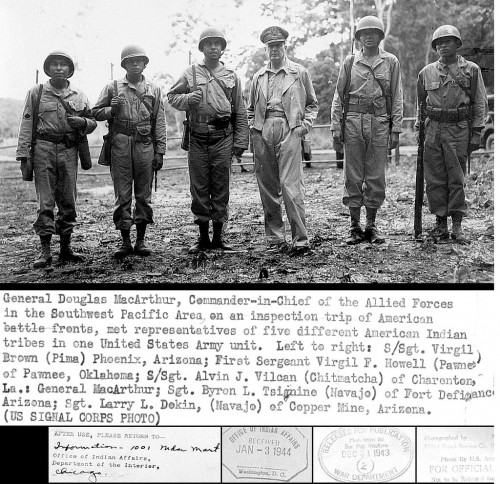The amazing thing about General MacArthur’s South West Pacific Area (SWPA) Theater is how amazingly bad the histories on it are. The place spun off more under or unreported “will-o-the-wisp” logistical and intelligence institutions than any four Hollywood movie franchises threw out sequels. You could add together the Fast & Furious, Star Wars and Marvel Superhero movie sequels and still be low.
Today’s column on the 5th Air Force provisional American Indian code talker unit started during a hunt for the radar hunting Field Units of Section 22 — the SWPA theater electronic intelligence organization — and found this specially trained for the invasion of Japan unit of the “Vth Bomber Command”** by accident. Other research I had done showed Section 22 transferred all of its US Army Air Force and US Navy field units back to the respective services. To track that transition, I was looking through a Air Force Historical Research Agency (AFHRA) digitized microfilm, REEL A7509, on the history of the 5th Air forces “Vth Bomber Command” for April through September 1945. On pages 1318 and 1319 of 1841 I ran into the following —
Experiments are being conducted in the use of teams of American Indians to be used for communications between this headquarters and headquarters of Subordinate unite in case telephone lines go out of operation or, in case of moves, until regular lines of communications can be installed. Indians with various units of the V Bomber Command have been assembled at this headquarters where a course in communications is being conducted. It is expected that the Indians, speaking in their native language, will be used to pass administrative traffic talking in the place of codes on the Frequency Modulation Voice circuit.
In some ways it isn’t surprising that the Vth Bomber Command turned to Indian code talkers. At the direction of General MacArthur. the radio platoon of the 302nd reconnaissance Troop, 1st Cavalry Division recruited Lakota and Dakota Indians who used their Sioux language to communicate to other Divisional Headquarters troops. MacArthur also did the same with Navajo Alamo Scout graduates who returned to the Intelligence and Reconnaissance Platoon of the 158th Regimental Combat Team (RCT).

These Vth Bomber Command code talkers, like those of the 158th RCT & 1st Cavalry Division, would have played a major role in Operation Olympic landings, as the US Army had in July 1945 just discovered that the Japanese “walkie-talkie” Type 94 (1934) Mark 6 radios could monitor the U. S. SCR-610 and SCR-608 frequency modulated (FM) radio sets with American infantry and tank units. Prior to that discovery, American troops thought FM radios were secure from Japanese monitoring and took no security precautions with them. The ability of the battalion level Japanese “walkie-talkie” field radios to hear American FM tank radios may have been a huge and unexamined contributing cause to the massacre of 22 tanks belonging to the 193rd Tank Battalion on 19 April 1945 at the Okinawan Battle of Kakazu Ridge.
The establishment of a USAAF unit to do the same shows a realistic acknowledgement of the threat of Japanese eavesdropping on American F.M. radio communications by MacArthur’s commanders. An acknowledgement of the threat that was notably lacking in Adm. Nimitz’s Central Pacific theater — USMC Indian code talkers or not — but that is the subject for another column.
Military Culture and Technology Note:
** A Bomber or Fighter Command in the WW2 USAAF was a Corps level equivalent command. The use of Roman number for “Fifth” is an adaption of the Western Army tradition of using Roman numerals for a Corps level formations.
COMMON FM RADIO SETS USED IN US WWII AFVs
Radio Set — Components/Description
SCR 538 — FM/voice only, 10 miles max, no transmitter, 1 BC 603 receiver w/ BC 605 interphone amplifier, 9”² whip antenna, typical tank set in early war years
SCR 528 — FM/voice only, 10 miles max, BC 604 transmitter (20 Watts, 10 crystal channels, 8 tubes) w/BC 605 interphone, BC 603 receiver, 9”² whip antenna, platoon leader and typical late-war tank set
SCR 508 — FM/voice only, 10 miles max, BC 604 transmitter w/ BC 605 interphone, 2 BC 603 receivers, 9”² whip antenna, tank company commander
SCR 506 — AM/25-50 miles voice, 75-100 miles key, BC 653 transmitter (50 Watts, 4 tubes), BC 652 receiver, BC 658 interphone switch box, 15”² whip antenna, battalion commander, when 506 was not avail, older SCR 245 or SCR 193 w/ less range was used
Trent,
You are uncovering a LOT of surprising information. I had never heard of MacArthur using Indians for communicators.
>>I had never heard of MacArthur using Indians for communicators
I wrote previously on some of MacArthur’s Indian code talkers in June 2013 here —
History Friday: MacArthur’s Sioux Code Talkers
https://chicagoboyz.net/archives/36899.html
What was interesting this time out was when I was looking up that MacArthur photo above for this post. It uncovered the Navajo Alamo Scout graduates who returned to the Intelligence and Reconnaissance Platoon of the 158th Regimental Combat Team as an added bonus.
I must have missed that installment….
I had some interesting feedback from the photo above from the Alamo Scout Historical Foundation.
Three of the five Indian soldiers in the photo above Graduated from the Alamo Scout Training Center (ASTC).
First Sgt Howell, S/Sgt Vilcan and Sgt. Tsignine were all 1st class graduates of the ASTC. First Sgt Howell was assigned to the Sombar Team. S/Sgt Vilcan and Sgt. Tsignine returned to their original units.
The first class at ASTC started 27 Dec 1943, so that photograph had to of been taken before they started Alamo Scouts training.
MacArthur took such a personal interest in the Alamo Scouts that he was doing PR photos with them before the first class started.
That puts a very different shine on a number of things I have researched regards Generals Krueger, Charles Andrew Willoughby (MacArthur’s G-2 intelligence officer) and MacArthur himself.